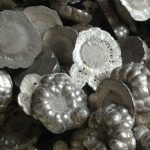Notice: Undefined index: sith_hide_share in /www/sites/alloy.wiki/index/wp-content/themes/likegoogle/single.php on line 32
Deprecated: get_settings is deprecated since version 2.1.0! Use get_option() instead. in /www/sites/alloy.wiki/index/wp-includes/functions.php on line 4862
Crack is a common defect in titanium bar products, which is caused by many reasons, the most important being that there are four kinds of defects: a large number of non-metal inclusions, surface decarburization, banded structure and sulfide inclusions in the rod matrix.

1. Inclusions
The inclusions at the crack of bar are mainly composite inclusions of tunic refractory, silicoaluminate and crystallizer protective slag.
Measures: to optimize argon blowing process by controlling the superheat of molten steel in tundish; Adopt protective pouring to prevent secondary oxidation and adopt off-furnace refining technology; To prevent the tunged-water mouth from being blocked, and to reduce the sharp fluctuation of the mould level; Strictly ensure the casting system, avoid open casting as much as possible, to ensure the stability of casting process temperature and pull speed.
2. Decarburization
The cracks caused by decarbonization in steel are easy to occur in high carbon and high manganese steel, and the decarbonization caused by hot rolling is easy to cause defects in the subsequent process. After the decarbonization of austenitic high carbon and high manganese steel, the surface structure becomes uneven.
Measures: to reduce the heating temperature of the steel and the residence time in the high temperature state; When necessary, add protective gas in heating furnace to prevent the oxidation of billet; Adding charcoal in the furnace can reduce the content of O2 and H2O in the furnace and reduce the decarburization. Coating the surface of billet with anti-oxidation material can effectively avoid decarburization.
3. Banded organization
The strip structure is a kind of internal defect of steel. The strip structure is formed by the segregation of alloy elements. It often appears in the microstructure of hot rolled mild steel.
Measures: optimize steelmaking and continuous casting process to avoid dendrite segregation in billet. In the process of continuous casting, the casting temperature can be reduced by controlling the superheat of molten steel. Electromagnetic stirring was used to break the dendritic crystal and enlarge the equiaxial crystal zone. Control the water amount in the secondary cooling zone, the water amount is not too large, reduce the width of columnar crystal zone; Measures such as optimizing casting speed can avoid the appearance of banded structure from the source of blank.
4. Sulfur compounds
Generally, some spherical inclusions are observed at the cracks, and the binding force of sulfide is weak with the steel matrix. When the stress concentration occurs, it is easy to separate from the matrix and generate crack source.
Measures: optimize desulphurization means, add proper amount of titanium and calcium in the metamorphic agent, reduce the sulfur content and size of sulfide; Optimization of continuous casting process, inhibition of sulfur segregation, so that the performance of steel more stable; In the process of steelmaking, sufficient argon blowing time is ensured while continuous mixing, so that the inclusions float up.
Guest contributors are welcome at the Alloy Wiki.It is a weekly wiki and guide on alloy information and processing technology, while also about the vast array of opportunities that are present in manufacturing. Our team of writers consists of a Machining Material Supplier / Machinist / Tool and Die Maker, a Biomedical Engineer / Product Development Engineer, a Job Development Coordinator / Adjunct Professor, and a President and CEO of a manufacturing facility.
Link to this article:The cause and control of titanium bar crack
Reprint Statement: If there are no special instructions, all articles on this site are original. Please indicate the source for reprinting:Alloy Wiki,thanks!^^


